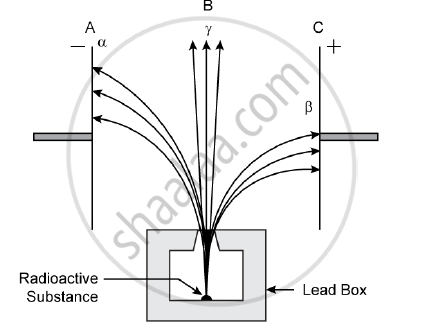Advertisements
Advertisements
प्रश्न
Radiations given out from a source when subjected to an electric field in a direction perpendicular to their path are shown below in the diagram. The arrows show the path of the radiation A, B and C. Answer the following questions in terms of A, B and C.

1) Name the radiation B which is unaffected by the electrostatic field.
2) Why does the radiation C deflect more than A?
3) Which among the three causes the least biological damage externally.
4) Name the radiation which is used in carbon dating.
उत्तर
1) Gamma radiations
2) Because of the mass of B particle is less than that of α, hence radiation deflects more than A.
3) `gamma` rays
4) beta radiation `""_6^14C -> ""_7^14N + ""_(-1)^0beta^(-)`
APPEARS IN
संबंधित प्रश्न
A radiation X is focused by a particular device on the bulb of a thermometer and mercury in the thermometer shows a rapid increase. Name the radiation X
How can they be made to leave the metal surface? (State any two ways)
State the energy conversion taking place in a cathode ray tube
What happens to the atomic number of element when (i) An α -particle, (ii) A β -particle 1 and (iii) γ-radiation is emitted?
Draw a diagram of a simple atom showing the nucleus and electrons. In this atom:
(a) What type of charge will there be on the nucleus?
(b) What is the value of this charge?
A radioactive substance is oxidized. What changes would you expect to take place in the nature of radioactivity? Explain your answer.
During the emission of a beta particle, the ______ number remains same.
State any two uses of cathode rays.
Name the three main parts of a Cathode Ray Tube.
State one use of radio-isotopes.
